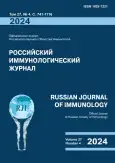A view of immunologic male infertility from the perspective of preserving seminal fluid homeostasis
- 作者: Minasova A.A.1, Savochkina A.Y.1, Nokhrin D.Y.2, Sharabakina K.A.1, Pashkina N.V.3, Nikushkina K.V.1
-
隶属关系:
- South-Ural State Medical University
- Chelyabinsk State University
- Medical Center “Lotos”
- 期: 卷 27, 编号 4 (2024)
- 页面: 967-974
- 栏目: SHORT COMMUNICATIONS
- URL: https://journal-vniispk.ru/1028-7221/article/view/267914
- DOI: https://doi.org/10.46235/1028-7221-16904-AVO
- ID: 267914
如何引用文章
全文:
详细
The basis of the pathogenesis of immunologic male infertility is the production of antisperm antibodies against sperm antigens by plasmocytes. Extracellular nucleic acids, among other antigens, are perceived as DAMPs. The clearance system for biological fluids is complex. Endonucleases are responsible for the utilization of extracellular DNA. Among endonucleases, DNase 1 is the most studied. Its concentration in biological fluids is higher than others. For the first time, we determined the concentration of DNase 1 in the seminal fluid of men of reproductive age. DNase 1 concentration values were compared with the level of antisperm antibodies in the ejaculate, after which the relationship between the enzyme level and standard spermogram parameters was determined. The material for the study was the ejaculate of 44 relatively healthy men of reproductive age. During spermiological analysis, macroscopic and microscopic parameters of seminal fluid were determined, the concentration of deoxyribonuclease 1 (DNase 1) in the material was determined by enzyme immunoassay, and the presence of antisperm antibodies was assessed using a direct diagnostic method – the MAR test. Statistical processing of the obtained data was carried out using analytical software PAST v. 4.06. Reference intervals for DNase 1 concentrations were calculated using the MedCalc v. 17.4 program. The relationship between spermogram parameters and DNase 1 concentration was assessed by calculating Spearman’s linear rank correlation coefficients. As a result, a negative correlation was found between the DNase 1 ratio and such ejaculate parameters as liquefaction time (rS = -0.37; p = 0.013) and viscosity (rS = -0.37; p = 0.013), as well as the level of antisperm antibodies A (rS = -0.43; p = 0.003) and G (rS = -0.33; p = 0.027), the mucous component of the ejaculate (rS = -0.37; p = 0.012) and agglutination of male germ cells (rS = -0.33; p = 0.029). According to the data obtained, the optimal level of DNase 1 is directly related to the quality of the ejaculate. Determination of DNase 1 concentration can serve as an additional diagnostic criterion for male immunological infertility. These data will expand our understanding of a man’s fertile potential.
作者简介
A. Minasova
South-Ural State Medical University
编辑信件的主要联系方式.
Email: pandora_anna@mail.ru
PhD (Biology), Senior Research Associate, Research Institute of Immunology
俄罗斯联邦, 64 Vorovsky St, Chelyabinsk, 454092A. Savochkina
South-Ural State Medical University
Email: pandora_anna@mail.ru
PhD, MD (Medicine), Associate Professor, Head, Department of Microbiology, Virology and Immunology
俄罗斯联邦, 64 Vorovsky St, Chelyabinsk, 454092D. Nokhrin
Chelyabinsk State University
Email: pandora_anna@mail.ru
PhD (Biology), Associate Professor, Department of Microbiology, Immunology and General Biology
俄罗斯联邦, ChelyabinskK. Sharabakina
South-Ural State Medical University
Email: pandora_anna@mail.ru
Senior Laboratory Assistant, Research Institute of Immunology
俄罗斯联邦, 64 Vorovsky St, Chelyabinsk, 454092N. Pashkina
Medical Center “Lotos”
Email: pandora_anna@mail.ru
Obstetrician-Gynecologist, Reproductologist
俄罗斯联邦, ChelyabinskK. Nikushkina
South-Ural State Medical University
Email: pandora_anna@mail.ru
PhD (Medicine), Leading Research Associate, Research Institute of Immunology
俄罗斯联邦, 64 Vorovsky St, Chelyabinsk, 454092参考
- Божедомов В.А., Николаева М.А., Спориш Е.А., Рохликов И.М., Липатова Н.А., Ушакова И.В., Логинова Н.С., Сухих Г.Т. Этиопатогенез аутоиммунных реакций против сперматозоидов // Андрология и генитальная хирургия, 2012. № 4. С. 45-53. [Bozhedomov V.A., Nikolaeva M.A., Sporish E.A., Rokhlikov I.M., Lipatova N.A., Ushakova I.V., Loginova N.S., Sukhikh G.T. Etiopathogenesis of autoimmune reactions against sperm. Andrologiya i genitalnaya khirurgiya = Andrology and Genital Surgery, 2012, no. 4. pp. 45-53. (In Russ.)]
- Шевырин А.А. Современный взгляд на лечение нарушений мужской фертильной функции // РМЖ, 2018. № 12. C. 30-35. [Shevyrin A.A. Modern view on the treatment of male fertility disorders. RMZh = Russian Medical Journal, 2018, no. 12, pp. 30-35. (In Russ.)]
- CLSI. Defining, establishing and verifying reference intervals in the clinical laboratory; approved guideline; third edition CLSI document EP28-A3c; Clinical and Laboratory Standards Institute: Wayne, PA, USA, 2008. Available at: https://pdf4pro.com/view/ep28-a3c-defining-establishing-and-verifying-reference-7a58f8.html.
- Heil M., Vega-Muñoz I. Nucleic acid sensing in mammals and plants: facts and caveats. Int. Rev. Cell Mol. Biol., 2019, Vol. 345, pp. 225-285.
- Keyel, P.A. Dnases in health and disease. Dev. Biol., 2017, Vol. 429, no.1, pp. 1-11.
- Podgrajsek R., Hodzic A., Stimpfel M., Kunej T., Peterlin B. Insight into the complexity of male infertility: a multi-omics review. Syst. Biol. Reprod. Med., 2024, Vol. 70, pp. 73-90.
- Tang Q., Chen Y., Wu W., Ding H., Xia Y., Chen D., Wang X. Idiopathic male infertility and polymorphisms in the DNA methyltransferase genes involved in epigenetic marking. Sci. Rep., 2017, Vol. 7, 11219. doi: 10.1038/s41598-017-11636-9.
- WHO laboratory manual for the examination and processing of human semen, fifth edition. World Health Organization., 2010, p. 271. Available at: https://fctc.who.int/publications/i/item/9789241547789.
补充文件








